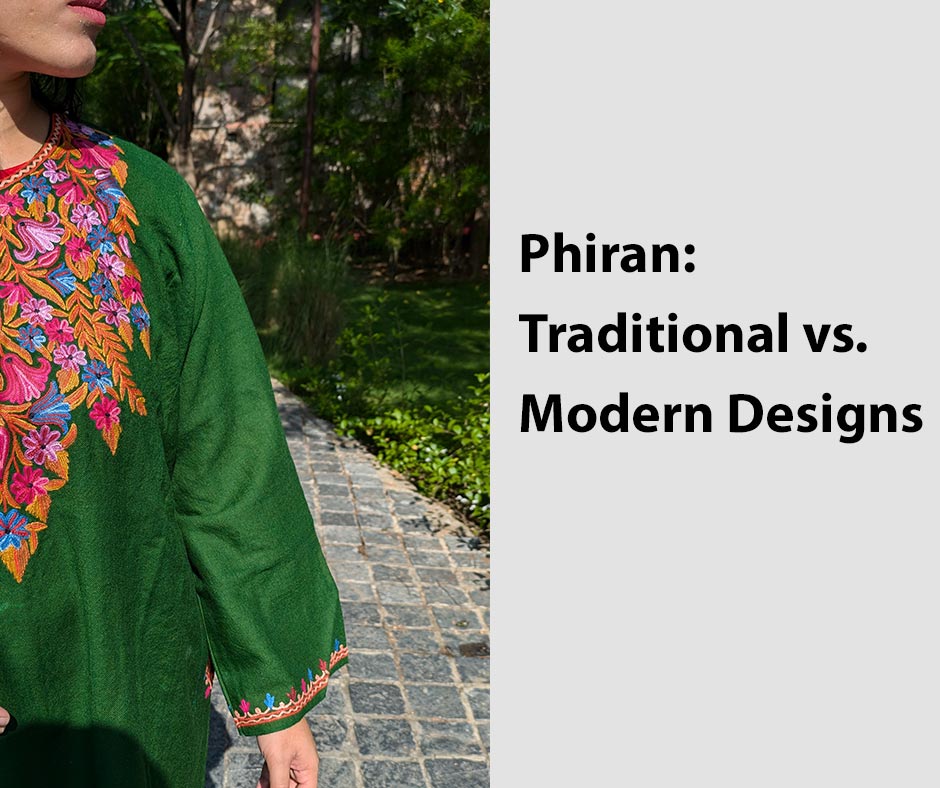Editorial
Phiran: Traditional vs. Modern Designs

The phiran is a garment that has been an essential part of Kashmiri culture for centuries, reflecting both practicality and artistry. Traditionally worn to stay warm in the harsh winter months, this long, loose-fitting garment has transformed over time, adapting to modern tastes while retaining its cultural essence. In this article, we’ll explore the distinctions between traditional and modern phiran designs, from fabric choices and colors to structure and stylistic features.
Traditional Phiran: Dark Colors and Heavier Fabrics
Historically, the phiran was crafted primarily from heavy, dark-colored fabrics. Traditional phirans often featured pattu tweeds, a dense woolen fabric known for its warmth and durability, ideal for shielding wearers from the cold. Dark colors like black, brown, and deep blues were most common, chosen not only for aesthetic appeal but also for their practical advantage in hiding stains and wear. The heavier fabric provided significant warmth, especially in the mountainous regions of Kashmir.
Another distinct feature of the traditional phiran was its inner lining, known as pozh, which added an extra layer of insulation. This lining, typically made from soft cotton or wool, kept the garment snug and warm, making it indispensable during Kashmir’s cold winters.
Iconic Design: The Qurab Style
Traditional phirans often followed the qurab design, an iconic style that reflected a more modest and structured silhouette. The qurab design was notable for its unique arm structure, where the sleeves were crafted to be worn folded. This added to the phiran’s layered appearance and gave it an air of quiet elegance. The folded arms were practical, allowing for ease of movement while still maintaining warmth, and it became a signature look that signified traditional Kashmiri attire.
Modern Phiran: Diverse Fabrics and Updated Styles
While traditional phirans still hold a revered place in Kashmiri fashion, modern phirans have embraced a variety of fabrics and designs to appeal to contemporary tastes. Today, phirans are made in a wide range of materials, including not only tweed but also cashmilon, raffal, and even luxurious pashmina. These fabrics offer a lighter and softer feel, allowing the phiran to be worn comfortably both indoors and outdoors and in more varied climates.
Modern phirans also explore a broader color palette. While traditional phirans favored darker hues, modern designs feature lighter colors such as pastel pinks, blues, and even whites. This shift in color choices reflects the modern phiran’s broader appeal, making it suitable for casual outings and even formal gatherings. With updated styling, modern phirans are now commonly worn without the pozh lining, as lightweight materials and central heating reduce the need for extra insulation.
Embracing New Silhouettes and Patterns
Modern phirans depart from the rigid structure of the qurab style, allowing for more flexibility in arm movement and overall fit. With variations in sleeve length and wider necklines, these phirans provide a modern aesthetic that aligns with current fashion trends. Additionally, traditional motifs are often replaced or complemented with embroidery, printed patterns, or woven designs that appeal to a broader audience.
Cultural Symbolism and Fusion of Tradition with Modernity
Despite these changes, modern phiran designs still pay homage to the cultural heritage of Kashmir. Many contemporary designers incorporate traditional Kashmiri embroidery and craftsmanship into their designs, creating a fusion of the old and new. This blend preserves the rich legacy of the phiran while adapting it to suit modern preferences and functional needs.
The shift in materials, colors, and designs reflects not only the adaptability of Kashmiri fashion but also the timeless appeal of the phiran. It remains a symbol of Kashmiri identity and heritage, even as it continues to evolve. Whether in its traditional, heavy pattu form or in a light, modern raffal fabric, the phiran’s journey from tradition to modernity shows how deeply it is woven into both the history and the future of Kashmiri culture.
In essence, the phiran represents the best of both worlds: a garment steeped in history and tradition yet dynamic enough to evolve with changing times.
